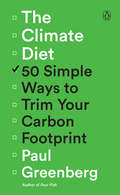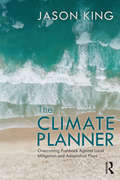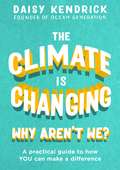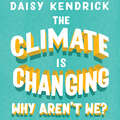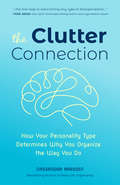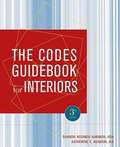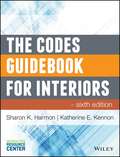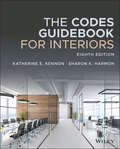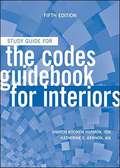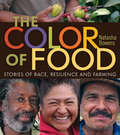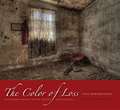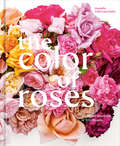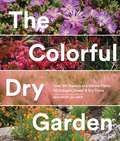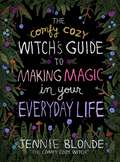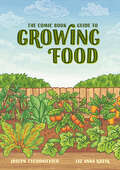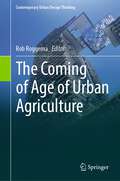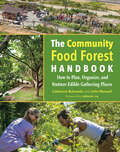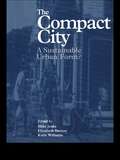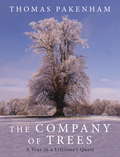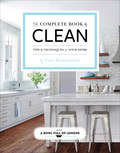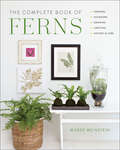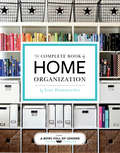- Table View
- List View
The Climate Diet: 50 Simple Ways to Trim Your Carbon Footprint
by Paul GreenbergA celebrated writer on food and sustainability offers fifty straightforward, impactful rules for climate-friendly living"Some strong and rational suggestions for reducing your personal impact here--and when you're eating smart, you'll have the energy to do the movement building we need to change systems too! This book integrates the individual and the societal in a powerful way."--Bill McKibbenWe all understand just how dire the circumstances facing our planet are and that we all need to do our part to stem the tide of climate change. When we look in the mirror, we can admit that we desperately need to go on a climate diet. But the task of cutting down our carbon emissions feels overwhelming and the discipline required hard to summon. With The Climate Diet, award-winning food and environmental writer Paul Greenberg offers us the practical, accessible guide we all need. It contains fifty achievable steps we can take to live our daily lives in a way that's friendlier to the planet--from what we eat, how we live at home, how we travel, and how we lobby businesses and elected officials to do the right thing. Chock-full of simple yet revelatory guidance, The Climate Diet empowers us to cast aside feelings of helplessness and start making positive changes for the good of our planet.
The Climate Planner: Overcoming Pushback Against Local Mitigation and Adaptation Plans
by Jason KingThe Climate Planner is about overcoming the objections to climate change mitigation and adaption that urban planners face at a local level. It shows how to draft climate plans that encounter less resistance because they involve the public, stakeholders, and decisionmakers in a way that builds trust, creates consensus, and leads to implementation. Although focused on the local level, this book discusses climate basics such as carbon dioxide levels in the atmosphere, the Intergovernmental Panel on Climate Change, the Paris Agreement of 2015, worldwide energy generation forecasts, and other items of global concern in order to familiarize urban planners and citizen planners with key concepts that they will need to know in order to be able to host climate conversations at the local level. The many case studies from around the United States of America show how communities have encountered pushback and bridged the implementation gap, the gap between plan and reality, thanks to a commitment to substantive public engagement. The book is written for urban planners, local activists, journalists, elected or appointed representatives, and the average citizen worried about climate breakdown and interested in working to reshape the built environment.
The Climate is Changing, Why Aren't We?: A practical guide to how you can make a difference
by Daisy Kendrick'An inspirational and motivational must-read, packed with practical tips to push for positive change' Zanna van DijkThe climate is changing, so why aren't we? After all, we are the generation of change. The severity of climate change leaves no one indifferent. The Climate is Changing, Why Aren't We? will not try to convince you that climate change exists - we know that. It offers easy to understand insights into the structures that suffocate our future, while upholding a sense of optimism and humanising the climate story. From the clothes you buy, plastics you use and food you eat, to knowing how to harness the power of social media and technology to get our voices heard and demand climate action, Daisy Kendrick, founder of Ocean Generation, weaves together inspirational stories, shocking statistics and easy green switches to make in your everyday life to tackle climate change on an individual level. The Climate is Changing, Why Aren't We? will help to grant future generations the rights they deserve.
The Climate is Changing, Why Aren't We?: A practical guide to how you can make a difference
by Daisy Kendrick'An inspirational and motivational must-read, packed with practical tips to push for positive change' Zanna van DijkThe climate is changing, so why aren't we? After all, we are the generation of change. The severity of climate change leaves no one indifferent. The Climate is Changing, Why Aren't We? will not try to convince you that climate change exists - we know that. It offers easy to understand insights into the structures that suffocate our future, while upholding a sense of optimism and humanising the climate story. From the clothes you buy, plastics you use and food you eat, to knowing how to harness the power of social media and technology to get our voices heard and demand climate action, Daisy Kendrick, founder of Ocean Generation, weaves together inspirational stories, shocking statistics and easy green switches to make in your everyday life to tackle climate change on an individual level.The Climate is Changing, Why Aren't We? will help to grant future generations the rights they deserve.
The Climate is Changing, Why Aren't We?: A practical guide to how you can make a difference
by Daisy Kendrick'An inspirational and motivational must-read, packed with practical tips to push for positive change' Zanna van DijkThe climate is changing, so why aren't we? After all, we are the generation of change. The severity of climate change leaves no one indifferent. The Climate is Changing, Why Aren't We? will not try to convince you that climate change exists - we know that. It offers easy to understand insights into the structures that suffocate our future, while upholding a sense of optimism and humanising the climate story. From the clothes you buy, plastics you use and food you eat, to knowing how to harness the power of social media and technology to get our voices heard and demand climate action, Daisy Kendrick, founder of Ocean Generation, weaves together inspirational stories, shocking statistics and easy green switches to make in your everyday life to tackle climate change on an individual level. The Climate is Changing, Why Aren't We? will help to grant future generations the rights they deserve.
The Clutter Connection: How Your Personality Type Determines Why You Organize the Way You Do
by Cassandra AarssenYou&’re not messy—you just organize differently. Learn to make your natural habits work for you with this bestseller by the host of HGTV&’s Hot Mess House! Organizing isn&’t one size fits all. By discovering your unique Organizing Personality Type, you can find the most effective strategies for a more productive and clutter-free life. The Clutter Connection examines and explains how different brain types directly relate to organization and clutter. Cassandra Aarssen smashes the stereotype that some people are &“naturally messy&” and offers insight and real-life solutions based on your unique personal organizing style. The Clutter Connection will help you get organized, be more productive and finally understand the why behind your clutter. Find out what type of Clutterbug you are and learn: · The four different organizing styles and how they relate to each other · How motivation and happiness can be directly affected by our space · The &“3P&’s&”─Productivity, procrastination, and perfectionism, and how they&’re connected to your unique organizing style · How you can finally become clutter-free simply by knowing yourself better
The Clutter Remedy: A Guide to Getting Organized for Those Who Love Their Stuff
by Marla StoneThe Way to a Perpetually Organized Lifestyle There are many valid approaches to creating neat and tidy spaces, but these approaches tend to fail over time because they suggest that we dispose of our stuff, and most of us love our stuff! Marla Stone&’s fresh and friendly approach, based on her work as both a professional organizer and a former psychotherapist, goes beyond tidying up to offer the Clutter Remedy strategy that will create spaces you love and keep you perpetually organized. Marla walks you through a process of getting to know yourself and your values and then visualizing your ideal lifestyle and optimal surroundings. From that perspective, you&’ll learn step by step (and room by room) how to create your ideal lifestyle and organize your space to support it.
The Codes Guidebook for Interiors
by Sharon Koomen Harmon Katherine E. KennonThe Codes Guidebook for Interiors, Fifth Edition features jargon-free explanations of all the codes and standards of concern to designers and architects, including performance codes, fire codes, building and finish standards, energy codes, and Americans with Disabilities standards. The book uses an easy-to-navigate format that is geared towards the code process as a whole, to take readers step-by-step through the codes relevant at each stage in the design process. Dozens of examples and a greatly enhanced set of illustrations, show how codes apply to real-world projects.
The Codes Guidebook for Interiors
by Katherine E. Kennon Sharon K. HarmonThe Interactive Resource Center is an online learning environment where instructors and students can access the tools they need to make efficient use of their time, while reinforcing and assessing their understanding of key concepts for successful understanding of the course. An access card with redemption code for the online Interactive Resource Center is included with all new, print copies or can be purchased separately.(***If you rent or purchase a used book with an access code, the access code may have been redeemed previously and you may have to purchase a new access code (ISBN: 9781118990179).The online Interactive Resource Center contains resources tied to the book, such as:Interactive Forms and ChecklistsDownloadable BibliographyFlashcards by chapter for focused learningGet up to speed on the latest codes with the complete reference for interiors.The Codes Guidebook for Interiors, Sixth Edition is the standards reference of choice for designers and architects, and the only guide devoted exclusively to codes applicable to interiors. With jargon-free explanations of all standards and regulations of concern to designers and architects, the book takes readers step-by-step through the codes relevant to each stage in the design process. The updated sixth edition features the latest information on fire codes, performance codes, building and finish standards, energy codes, and accessibility regulations, plus enhanced illustrations that clearly demonstrate how codes apply in real-life scenarios.Interior designers, architects, and facility managers need a basic understanding of the various codes involved with building interiors. These codes are updated on a continuous basis, and professionals must stay on top of new requirements and upcoming codes processes. The Codes Guidebook for Interiors is a complete reference, organized by stage for easy navigation, and comprehensive enough for use as a review for the NCIDQ and ARE exams. The sixth edition contains the most recent developments in interior codes and regulations, including:2012 ICC codes, including the IBC, and ICC International Green Construction CodeCoverage of changes to ADA standards and ICC/ASI accessibility requirementsNew standards, terminology, and federal regulationsUpdated information on sustainability as it relates to codes and regulations Having all applicable codes in a single resource saves hours of research time, and can dramatically reduce the potential for costly planning oversights. Whether renovation or new construction, small or large, codes apply to every project. The Codes Guidebook for Interiors provides designers with the comprehensive information they need to stay up-to-date.
The Codes Guidebook for Interiors
by Katherine E. Kennon Sharon K. HarmonTHE INTERIOR CODES AND STANDARDS REFERENCE OF CHOICE FOR DESIGNERS AND ARCHITECTS—UPDATED FOR THE 2018 AND 2021 CODES If you are involved with the design or management of buildings and spaces, it is important to remain up-to-date on the ever-evolving codes and standards that keep communities safe. With over 80,000 copies sold, The Codes Guidebook for Interiors continues to provide comprehensive explanations of the major codes and standards applicable to commercial and residential interior projects. The easily navigable format gives clear perspective to how these often confusing concepts and requirements are integrated into real world practice, helping designers incorporate the relevant standards into their projects. Updated with the most recent changes and insights to the codes and standards of the ICC, NFPA, ANSI, ADA, and other standards, the Eighth Edition provides unparalleled and integrated guidance on building safety, accessibility, sustainability, energy efficiency, and more. Updates to the Eighth Edition include: Explanations of code requirements, highlighting the latest changes in the 2018 and 2021 ICC codes, including the International Building Code and the NFPA’s Life Safety Code Clarifications to how and when the ADA, ABA and the ICC/ANSI accessibility requirements will apply to a project Introduction to the codes and standards that address sustainability in typical projects In-depth examinations of fire and smoke resistant assemblies, fire protection systems, and plumbing and mechanical requirements A companion website with printable study flashcards, instructor’s manual, and PowerPoint slides for use in academic settings Digital and printable code checklists that can guide code research for professional projects and use in a design studio Current, practical, and relevant to nearly any interior or architectural project, The Codes Guidebook for Interiors provides invaluable insight and reference for both student and professional interior designers and architects.
The Codes Guidebook for Interiors, Study Guide
by Sharon Koomen Harmon Katherine E. KennonThe Codes Guidebook for Interiors, Fifth Edition features jargon-free explanations of all the codes and standards of concern to designers and architects, including performance codes, fire codes, building and finish standards, energy codes, and Americans with Disabilities standards. The book uses an easy-to-navigate format that is geared towards the code process as a whole, to take readers step-by-step through the codes relevant at each stage in the design process. Dozens of examples and a greatly enhanced set of illustrations, show how codes apply to real-world projects.
The Codes Guidebook for Interiors: Wiley E-text Folder And Interactive Resource Center Access Card
by Katherine E. Kennon Sharon K. HarmonInterior codes and standards reference of choice for designers and architects, updated and revised Completely revised and updated, the seventh edition of The Codes Guidebook to Interiors is the only book devoted exclusively to codes that are applicable to interior designers. The guide features jargon-free explanations of all the codes and standards that are relevant to designers and architects, including performance codes, building and finish standards, energy codes, and ADA standards. In addition, the dozens of examples and a greatly enhanced with a set of illustrations, including floor plans, that clearly show how codes apply to real-world project. Written by Katherine E. Kennon (a professional architect and facilities planner) and Sharon Koomen Harmon (a professional interior designer and educator) are experts on interior design and architecture codes. Updated coverage contains the most recent ICC codes, including the International Building Code and new material on the ICC International Green Construction Code, as well as the NFPA's most recent Life code. The authors address a wide-variety of building and project types (large and small) and they offer information on single family homes and historical and existing buildings. The seventh edition includes: Easy-to-navigate format geared toward the code process as a whole A step-by-step guide through the codes relevant at each stage in the design process The newest changes to the ADA Standards and ICC/ASI accessibility requirements A companion site that offers interactive checklists, flashcards, PowerPoint lecture slides, and an Instructor's Manual Having all applicable codes in a single resource saves hours of research time, and can dramatically reduce the potential for costly planning oversights. Whether renovation or new construction, small or large, codes apply to every project. The Codes Guidebook for Interiors provides designers with the comprehensive information they need to stay up-to-date.
The Color of Food: Stories of Race, Resilience and Farming
by Natasha BowensImagine the typical American farmer. Many people visualize sun-roughened skin, faded overalls, and calloused hands--hands that are usually white. While there's no doubt the growing trend of organic farming and homesteading is changing how the farmer is portrayed in mainstream media, farmers of color are still largely left out of the picture.The Color of Food seeks to rectify this. By recognizing the critical issues that lie at the intersection of race and food, this stunning collection of portraits and stories challenges the status quo of agrarian identity. Author, photographer, and biracial farmer Natasha Bowens's quest to explore her own roots in the soil leads her to unearth a larger story, weaving together the seemingly forgotten history of agriculture for people of color, the issues they face today, and the culture and resilience they bring to food and farming.The Color of Food teaches us that the food and farm movement is about more than buying local and protecting our soil. It is about preserving culture and community, digging deeply into the places we've overlooked, and honoring those who have come before us. Blending storytelling, photography, oral history, and unique insight, these pages remind us that true food sovereignty means a place at the table for everyone.Natasha Bowens is an author, farmer, and creator of the multimedia project The Color of Food. Her advocacy focuses on food sovereignty and social issues.
The Color of Loss
by Dan BurkholderThe devastation of New Orleans after Hurricane Katrina has been imprinted in our collective visual memory by thousands of images in the media and books of dramatic photographs by Robert Polidori, Larry Towell, Chris Jordan, Debbie Fleming Caffrey, and others. New Orleanians want the world to see and respond to the destruction of their city and the suffering of its people-and yet so many images of so much destruction threaten a visual and emotional overload that would tempt us to avert our eyes and become numb. In The Color of Loss, Dan Burkholder presents a powerful new way of seeing the ravaged homes, churches, schools, and businesses of New Orleans. Using an innovative digital photographic technology called high dynamic range (HDR) imaging, in which multiple exposures are artistically blended to bring out details in the shadows and highlights that would be hidden in conventional photographs, he creates images that are almost like paintings in their richness of color and profusion of detail. Far more intense and poetic than purely documentary photographs, Burkholder's images lure viewers to linger over the artifacts of people's lives-a child's red wagon abandoned in a mud-caked room, a molding picture of Jesus-to fully understand the havoc thrust upon the people of New Orleans. In the deserted, sinisterly beautiful rooms of The Color of Loss, we see how much of the splendor and texture of New Orleans washed away in the flood. This is the hidden truth of Katrina that Dan Burkholder has revealed.
The Color of Roses: A Curated Spectrum of 300 Blooms
by Danielle Dall'Armi Hahn&“The roses are glorious! The story of the rose farm, incredible. The photographs by Victoria Pearson, utterly extraordinary.&”—MARTHA STEWARTA unique photographic collection of 300 stunning roses that spans the full spectrum of the flower&’s shades and hues, creating a breathtaking rainbow that will amaze flower lovers of all kinds.Few flowers come in as many colors as the beloved rose. Curated by award-winning rosarian Danielle Dall&’Armi Hahn, who personally owns more than 40,000 roses, the flowers in The Color of Roses were selected not only for their glorious and subtle color combinations but also for optimal availability, repeat blooming, disease resistance, improved vase life, and fragrance.Organized by color, these 300 full-page photos take you on a journey through all the marvelous shades of white, yellow, pink, peach, purple, orange, red, caramel, and even green blossoms—not to mention striped and bicolor. This modern compilation of the world&’s 300 most beautiful roses includes the essential statistics for each one, including name, plant type and size, breeder, and more to help gardeners, rose lovers, and floral designers discover their new favorite.Roses have been treasured for centuries. They bloom from spring until frost, in virtually all but the most frigid zones and in a great range of varieties to suit every taste. The Color of Roses is the ultimate guide for selecting the perfect color rose for your garden, special event, or floral arrangement.
The Colorful Dry Garden: Over 100 Flowers and Vibrant Plants for Drought, Desert & Dry Times
by Maureen GilmerA design-focused, easy-to-use guide to colorful, eye-catching foliage and flowers for your whole yard, from the ground plain to the canopy, for homeowners and landscapers faced with replacing thirsty gardens in California and other dry regions in the Western US. If readers must reluctantly remove water-guzzling favorites from the garden, they need equally beautiful substitutes! This book is a visual treat that supports the transition to dry gardening by proving that gardeners can have all the gorgeous color and flowers they had in the past using just a fraction of the water. Maureen Gilmer provides chapters on design categories of plants--flowering shrubs, the ground plain, eye-catching accents, ephemeral flowers, perennials for color, animated plants and fine textures, canopy, and edibles--with profiles for each plant plus background info and top picks lists. The Colorful Dry Garden is unique because it features only bold plants that are also heavy bloomers despite heat and limited water. It also features more than just Western native plants by including varieties from the world's driest climates.
The Comfy Cozy Witch's Guide to Making Magic in Your Everyday Life
by Jennie BlondeFrom the host of the beloved podcast The Comfy Cozy Witch comes an accessible two-color illustrated guide resonant with cozy fall vibes, featuring spells, recipes, meditations, and practices to bring good magic into your daily life.“Jennie Blonde is one of the leading voices in witchcraft. She shows that it can be the warm and comforting hug you need the most.”—Amanda Lovelace, New York Times bestselling author of The Princess Saves Herself in This One Whether you’re a novice curious about witchcraft but aren’t sure where to start, or a seasoned witch interested in deepening your practice, this warm, accessible, and nurturing interactive guide shows you the way. The Comfy Cozy Witch’s Guide to Making Magic in Your Everyday Life combines the practical charm of The Little Book of Hygge with the down to earth wisdom of The Spell Book for New Witches and the practical advice of Grimoire Girl, Drawn from decades of popular podcaster Jennie Blonde’s experience, she shares seven tenets to help you begin and develop your own authentic practice:Acceptance: gentle exercises to reflect on our past journeysSimplicity: meditations to ground us in the presentBalance: self-care practices, like candle magic, to replenish our inner selvesDelight: practices to find joy in communityWarmth: building a cozy practice spaceReflection: journal prompts to help us stay centeredIntuition: learning to listen to ourselves and connect to our guidesThis beautifully designed book—filled with spell craft exercises, magical journaling prompts, delicious recipes, and do-it-yourself tips for the home and garden–has everything necessary to develop a witchcraft practice built on magical authenticity, comfort, and self-care.
The Comic Book Guide to Growing Food: Step-by-Step Vegetable Gardening for Everyone
by Joseph TychonievichThe first graphic novel guide to growing a successful raised bed vegetable garden, from planning, prepping, and planting, to troubleshooting, care, and harvesting.&“A fun read packed with practical advice, it&’s the perfect resource for new gardeners, guiding you through every step to plant, grow, and harvest a thriving and productive food garden.&”—Joe Lamp&’l, founder and creator of the Online Gardening AcademyLike having your own personal gardening mentor at your side, The Comic Book Guide to Growing Food is the story of Mia, an eager young professional who wants to grow her own vegetables but doesn't know where to start, and George, her retired neighbor who loves gardening and walks her through each step of the process. Throughout the book, "cheat sheets" sum up George's key facts and techniques, providing a handy quick reference for anyone starting their first vegetable garden, including how to find the best location, which vegetables are easiest to grow, how to pick out the healthiest plants at the store, when (and when not) to water, how to protect your plants from pests, and what to do with extra produce if you grow too much.If you are a visual learner, beginning gardener, looking for something new, or have struggled to grow vegetables in the past, you'll find this unique illustrated format ideal because many gardening concepts--from proper planting techniques to building raised beds--are easier to grasp when presented visually, step by step. Easy and entertaining, The Comic Book Guide to Growing Food makes homegrown vegetables fun and achievable.
The Coming of Age of Urban Agriculture (Contemporary Urban Design Thinking)
by Rob RoggemaFor a long time, urban agriculture initiatives have been explored and novel policy and planning practices have been investigated. With the global food crisis the role urban agriculture has to play becomes more and more urgent. The potentials are large: it brings social justice, it limits climate change, it provides a healthy urban condition, it stimulates biodiversity and gives disadvantaged people an economic opportunity. After 15 years in the making, the time is ripe to see whether the growing of food has established a prominent position in urban planning and policies, food productivity, safety and security, social well-being, the arts, and human health. In this volume several aspects of growing food in the city are explored. Urban Agriculture plays a significant role in society. Nevertheless, it did not become a mainstream topic in day-to-day practice. This book provides concrete solutions and clues how to give urban food production a crucial role in the future planning of urban environments.
The Community Food Forest Handbook: How to Plan, Organize, and Nurture Edible Gathering Places
by Catherine Bukowski John MunsellCollaboration and leadership strategies for long-term successFueled by the popularity of permaculture and agroecology, community food forests are capturing the imaginations of people in neighborhoods, towns, and cities across the United States. Along with community gardens and farmers markets, community food forests are an avenue toward creating access to nutritious food and promoting environmental sustainability where we live. Interest in installing them in public spaces is on the rise. People are the most vital component of community food forests, but while we know more than ever about how to design food forests, the ways in which to best organize and lead groups of people involved with these projects has received relatively little attention.In The Community Food Forest Handbook, Catherine Bukowski and John Munsell dive into the civic aspects of community food forests, drawing on observations, group meetings, and interviews at over 20 projects across the country and their own experience creating and managing a food forest. They combine the stories and strategies gathered during their research with concepts of community development and project management to outline steps for creating lasting public food forests that positively impact communities.Rather than rehash food forest design, which classic books such as Forest Gardening and Edible Forest Gardens address in great detail, The Community Food Forest Handbook uses systems thinking and draws on social change theory to focus on how to work with diverse groups of people when conceiving of, designing, and implementing a community food forest. To find practical ground, the authors use management phases to highlight the ebb and flow of community capitals from a project&’s inception to its completion. They also explore examples of positive feedbacks that are often unexpected but offer avenues for enhancing the success of a community food forest.The Community Food Forest Handbook provides readers with helpful ideas for building and sustaining momentum, working with diverse public and private stakeholders, integrating assorted civic interests and visions within one project, creating safe and attractive sites, navigating community policies, positively affecting public perception, and managing site evolution and adaptation. Its concepts and examples showcase the complexities of community food forests, highlighting the human resilience of those who learn and experience what is possible when they collaborate on a shared vision for their community.&“A highly useful guide based on the collective wisdom of people and communities who are defining this practice as they develop it on the ground. The thoughtful analysis of planning strategies and numerous case studies of active projects help us all understand what community food forests are and can be for the future.&”—Steve Gabriel, author of Silvopasture and coauthor of Farming the Woods
The Compact City: A Sustainable Urban Form?
by Katie Williams Mike Jenks Elizabeth BurtonThis book presents the latest thinking on the benefits and dangers of higher density urban living. It offers diverse opinions and research, from a wide range of disciplines, and gives an insight into both the theoretical debate and the practical challenges surrounding the compact city. Essential reading for anyone with an interest in sustainable urban development.
The Company of Trees: A Year in a Lifetime's Quest
by Thomas Pakenham'The master. Puts all other modern tree-writers in the shade' John Lewis-Stempel, author of MeadowlandThomas Pakenham is an indefatigable champion of trees. In The Company of Trees he recounts his personal quest to establish a large arboretum on the family estate, Tullynally in Ireland; his forays to other tree-filled parks and plantations; his often hazardous seed-hunting expeditions; and his efforts to preserve magnificent old trees and historic woodlands.Whether writing about the terrible storms breaking the backs of hundred-year-old trees or a fire in the peat bog on Tullynally which threatens to spread to the main commercial spruce-woods, his fear of climate change and disease, or the sturdy young saplings giving him hope for the future, his book is never less than enthralling.
The Complete Book of Clean: Tips & Techniques for Your Home
by Toni Hammersley&“Hammersley&’s bible of clean covers every corner of the home from the bathroom to the office…hundreds of tips.&”—The Star From the bestselling author of The Complete Book of Home Organization, this foolproof, eco-friendly guide to cleaning your home provides solutions to help keep every area of your home neat, safe and spotless. Learn the best seasons to tackle home projectsFind storage solutions to simplify the processTeach even the messiest kids to clean up after themselvesKnow what needs a deep-clean—and how oftenSubstitute earth-friendly kitchen supplies for toxic chemicalsTackle every mess, stain and dust-magnet—and keep things from getting out of hand in the future Whether you&’re a neat freak or new to the world of homekeeping, let Toni Hammersley be your guide to establishing routines, learning techniques, and mastering the best home cleaning hacks out there. Soon you&’ll find that no matter the number of pets, kids, or home traffic, maintaining a clean home can be a breeze.
The Complete Book of Ferns: Indoors * Outdoors * Growing * Crafting * History And Lore
by Mobee Weinstein2021 American Horticultural Society Book Award Winner: “A lovely and multifaceted exploration . . . as useful as it is educational.” —Publishers WeeklyThe Complete Book of Ferns is filled with botanical information, indoor and outdoor growing and care information, details on propagation, display ideas, and even craft projects. This gorgeous book is authored by Mobee Weinstein, Foreman of Gardeners at the New York Botanical Garden and a veteran guest on Martha Stewart Living and other shows.From otherworldly Staghorns—mounted like antler trophies in homes throughout the world—to classic Boston Ferns and newer varieties like Crispy Wave, ferns are definitely back in fashion. And to no one’s surprise. After all, ferns are among the very oldest plants on the planet, with a long and storied history. There are tens of thousands of known varieties. In the Victorian Era, ferns were an absolute craze for over fifty years. They re-emerged as integral home décor in the ’50s and ’60s, and decorated the “fern bars” of the ’80s. And they’re back again.This comprehensive reference starts its examination of ferns 400 million years ago, when the first species of this group of spore-reproducing plants appeared on Earth, exploring their evolution and eventual incorporation into human culture, including the powers associated with them and their practical and ornamental uses. Then, after an exploration of fern botany—its parts, how it grows, its variability in size and form, habitats, propagation, etc.—you’ll learn how to green your indoor and outdoor environments with ferns. Every aspect of care is covered: potting/planting, watering, fertilizing, pest and disease control, and more.Finally, you can explore creative planting projects, like terrariums, vertical gardens (living walls), mixed tabletop gardens, and moss baskets, and create pressed fern art, fabric wall hangings with chlorophyll-stained designs, cyanotypes, and handmade fern-decorated paper. You’ll soon understand why this ancient plant class continues to be all the rage.
The Complete Book of Home Organization: 200+ Tips And Projects
by Toni HammersleyA &“super useful&” guide to making your home feel more spacious—and your life feel more manageable (Westchester Magazine). Have you ever wished you had the time and tools to organize your house in a clutter-free, design-conscious, Pinterest-worthy way? From storage solutions and cleaning tips to secret space-saving methods and expert strategies, The Complete Book of Home Organization is packed with the tips and shortcuts you need to effectively organize your home. From small spaces and apartment solutions to how to tackle a big, messy home with a 15-week total home organization challenge, this book covers it all. It spells out everything you need to de-clutter your house, store your belongings, and keep your home—and life—in tip-top shape. Organize the 30 main spaces of your home, including the living and dining spaces, bedrooms and bathrooms, guest areas, baby and kids&’ rooms, utility spaces and garages, entryways and offices, patios and decks, closets and pet areas. Keep track of your pantry, holiday and craft supplies, weekly menu planning, keepsakes, and schedules. From the basement to the attic, this book covers every nook and cranny. With step-by-step instructions, detailed illustrations, and handy checklists, it&’s time to say goodbye to a messy home and wasted storage space!
